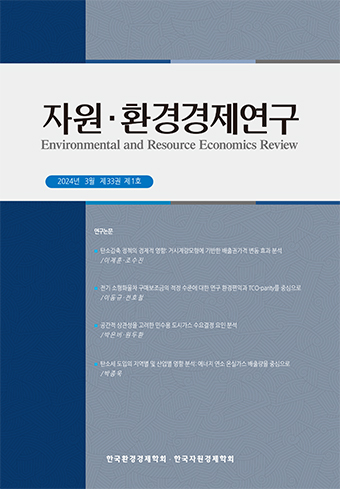Research Paper
Abstract
References
Information
The electric vehicle is a representative measure to reduce greenhouse gas and local air pollutants in the transportation sector. Most countries provide purchase subsidies and tax reductions to promote electric vehicle sales. The electric vehicles have been considered as zero-emission vehicles(ZEV) in light of the fact that there has been no pollutant emission during driving. However, recent studies have pointed out that the pollutant emitted from the process of generating electricity used for charging the electric vehicles need to be treated as emissions of the electric vehicles. Furthermore, the environmental benefits of electric vehicle replacing the internal combustion vehicle vary with the power mix. In line with the recent studies, this study analyzes the impact of electric vehicles based on the current power mix and future energy transition scenarios in Korea. To estimate the precise air pollutants emission profile, this study uses hourly electricity generation and TMS emission data for each power plant from 2015 to 2016. The estimation results show that the electric vehicles under the current power mix generate the environmental benefits of only -0.41~10.83 won/km. Also, we find that the environmental benefit of electric vehicle will significantly increase only when the ratio of the coal-fired power plant is reduced to a considerable extent.
전기자동차는 수송부문의 대표적인 온실가스 및 미세먼지 감축 대책으로 손꼽히고 있다. 세계 각 국가들은 전기자동차 보급 확대를 위해 구매 보조금 및 세제 감면 등의 자원제도를 시행하고 있다. 전기자동차는 주행 중에 발생하는 환경오염물질이 없다는 점에서 무배출차량(ZEV: Zero-Emission Vehicle)로 분류되지만 이는 전기자동차에 사용되는 전력을 생산하는 과정에서 발생되는 간접적인 배출을 고려하지 않은 것이다. 따라서 전기자동차의 보급에 따른 환경적 편익 증대는 전력 믹스에 따라 달라진다. 본 논문에서는 국내의 전원 구성 환경과 향후 진행될 에너지 전환에 따른 전기자동차의 환경적 영향을 분석하였다. 상세한 대기오염물질 배출 산정을 위해 각 발전소의 시간별 오염물질 배출과 발전량 데이터를 구축하여 발전소별 발전 효율 및 오염물질 배출량 저감 노력 등을 반영하였다. 분석결과 현재의 발전원별 비중에서는 전기자동차의 환경적 편익이 –0.41~10.83원/km에 불과한 것으로 분석되었다. 또한 에너지 전환 시나리오에 따른 전기자동차의 환경편익 분석결과 석탄 발전의 비중이 상당한 정도로 줄어드는 경우에만 전기자동차가 내연자동차에 비해 높은 수준의 환경 편익이 발생하는 것으로 나타났다.
- 국립환경과학원, “국가 대기오염물질 배출량 산정방법 편람(III)”, 2013.
- 김재경, “자동차의 전력화(electrification) 확산에 대비한 수송용 에너지 가격 및 세제 개편 방향 연구”, 에너지경제연구원, 2017.
- 안상진, “대기오염을 유발하는 전기차의 역설 : 전기차 보급 및 전력수급 정책의 고려사항”, KISTEP 한국과학기술기획평가원, 2017.
- 우종률, “전력믹스에 따른 전기자동차의CO2 배출량 비교분석”, 과학기술정책, 통권220호, 2016. 11.
- 전호철, “전기자동차 보급에 따른 지역간 오염물질 및 온실가스 배출 영향 분석”, 한국환경정책평가연구원, 2017.
- 환경부, “타이어 및 브레이크 패드 마모에 의한 비산먼지 배출량 및 위해성 조사”, 2012.
- Archsmith, J., A. Kendall, and D. Rapson, “From Cradle to Junkyard: Assessing the Life Cycle Greenhouse Gas Benefits of Electric Vehicles,” Research in Transportation Economics, Vol. 52, 2015, pp. 72~90.10.1016/j.retrec.2015.10.007
- EPA, Technical Update of the Social Cost of Carbon for Regulatory Impact Analysis Under Executive Order 12866, 2016.
- Gillingham, K., D. Rapson, and G. Wagner. “The Rebound Effect and Energy Efficiency Policy,” Review of Environmental Economics and Policy, Vol. 10, No. 1, 2016, pp. 68~88.10.1093/reep/rev017
- Graff Zivin, J. S., M. J. Kotchen, and E. T. Mansur, “Spatial and Temporal Heterogeneity of Marginal Emissions: Implications for Electric Cars and Other Electricity-Shifting Policies,” Journal of Economic Behavior and Organization, Vol. 107, 2014, pp. 248~68.10.1016/j.jebo.2014.03.010
- Holland, S. P., E. T. Mansur, and A. J. Yates, “Are There Environmental Benefits from Driving Electric Vehicles? The Importance of Local Factors,” American Economic Review, Vol 106, 2016, pp. 3700~3729.10.1257/aer.20150897
- Huo, H., H. Cai, Q. Zhang, F. Liu, and K. He, “Life-Cycle Assessment of Greenhouse Gas and Air Emissions of Electric Vehicles: A Comparison between China and the U.S.,” Atmospheric Environment, Vol. 108, 2015, pp. 107~116.10.1016/j.atmosenv.2015.02.073
- International Energy Agency(IEA), Global EV Outlook 2017: Two Million and Counting, IEA Publication, 2017b.
- International Energy Agency(IEA), World Energy Balances, IEA Publication, 2017a.
- Ji, S., C. R. Cherry, W. Zhou, R. Sawhney, Y. Wu, S. Cai, S. Wang, J. D. Marshall, “Environmental Justice Aspects of Exposure to PM2.5 Emissions from Electric Vehice Use in China,” Environmental Science and Technology, Vol. 49, No. 24, 2015, pp. 13912~13920.10.1021/acs.est.5b04927 26509330
- Liao, F., E. Molin, and B. V. Wee, “Consumer Preferences for Electric Vehicles: A Literature Review,” Transport Reviews, Vol. 37, No. 3, 2017, pp. 252~275.10.1080/01441647.2016.1230794
- Messagie, M., “Life Cycle Analysis of the Climate Impact of Electric Vehicles,” Transport & Environment, 2017.
- McLaren, J., J. Miller, E. O’Shaughnessy, E. Wood, and E. Shapiro, “CO2 Emissions Associated with Electric Vehicle Charging: The Impact of Electricity Generation Mix, Charging Infrastructure Availability and Vehicle Type,” Electricity Journal, Vol. 29, No. 5, 2016, pp. 72~88.10.1016/j.tej.2016.06.005
- OECD, “The Economic Consequences of Outdoor Air Pollution,” 2016.
- Parry, I. , D. Heine, E. Lis, and S. Li., Getting Energy Prices Right: From Principles to Practice, International Monetary Fund, 2014.
- Rezvani, Z., J. Jansson, and J. Bodin, “Advances in Consumer Electric Vehicle Adoption Research: A Review and Research Agenda, ” Transportation Research Part D: Transport and Environment, Vol. 34, 2015, pp. 122~136.10.1016/j.trd.2014.10.010
- Publisher :Environmental and Resource Economics Review
- Publisher(Ko) :자원 · 환경경제연구
- Journal Title :자원·환경경제연구
- Journal Title(Ko) :Environmental and Resource Economics Review
- Volume : 28
- No :2
- Pages :307~326
- DOI :https://doi.org/10.15266/KEREA.2019.28.2.307



 자원·환경경제연구
자원·환경경제연구






